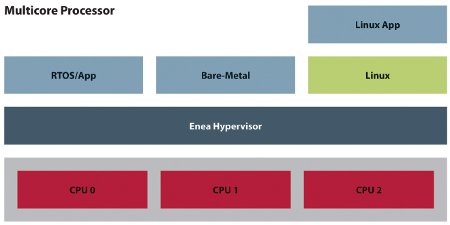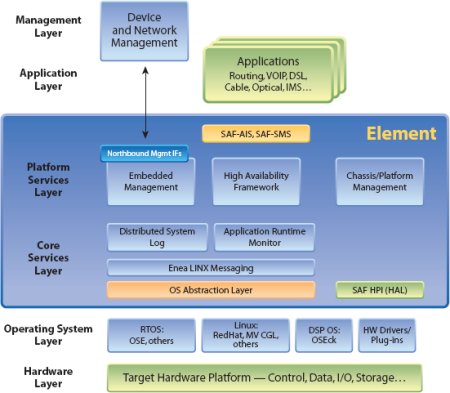Hypervisor supports Linux guests
Mar 5, 2010 — by Eric Brown — from the LinuxDevices Archive — viewsEnea announced a multi-core-focused “Enea Hypervisor,” which is based on its OSE real-time operating system, but supports Linux clients via its Linx inter-process communication protocol. Meanwhile, Enea announced that its Android Competence Center has been chosen by mobile anti-malware firm Fatskunk to develop an Android proof of concept.
As with other carrier-grade hypervisors, such as the Linux-based Wind River Hypervisor, the Enea Hypervisor implements multiple high performance computing environments on top of multi-core processors. Virtualizing multi-core processors in this way can lower development costs by enabling hardware consolidation on next generation network equipment, says Sweden-based telecom software giant Enea.
The Enea Hypervisor is based on Enea's telecom-oriented OSE micro kernel real-time operating system (RTOS), and can run Enea OSE applications at native processor speeds without compromising real-time critical properties, claims Enea. Yet, the Hypervisor can also accept Linux as a guest OS, says the company.
The Hypervisor's Linux compatibility is said to enable telecom developers who want to build on an RTOS platform, but also want to utilize third party Linux software. Hypervisor guests can also include semiconductor-specific executive environments for bare-metal speed packet processing as guests, says Enea. The Hypervisor initially supports two Freescale PowerPC-based processors: the dual-core Freescale MPC8572DS, as well as the more powerful multi-core Freescale QorIQ family.

Enea Hypervisor simplified architecture
OSE and Linux applications are said to co-exist in secure domains where common resources like memory and devices are protected. Enea Hypervisor also provides support for guest OS error handling, as well as Linux guest application crash analysis, says the company. Out-of-the-box support is said to be supplied for standard Kernel.org Linux, as well as for commercially supported Linux distributions.
In addition, Enea provides its Eclipse-based Enea Optima development tools for system and application debugging compatible with the Enea Hypervisor. The Optima Log Analyzer uses the Enea Hypervisor to support log fusion from applications and operating systems, providing a coherent system event view and analysis of the entire platform, says Enea.
Enea background: Accelerator, Element, and Linx
While Enea's principal business is to sell tools and services around its OSE RTOS, the company is known in the embedded Linux world for its telecom-oriented Enea Accelerator Platform, which is designed for IP-based services built on carrier-grade infrastructure. The soup-to-nuts Accelerator integrates a variety of telecom-oriented software, including Linx, and is built on MontaVista or Wind River Linux kernel distributions.
The major component of Accelerator is Enea's high-availability Element middleware, designed for heterogeneous telecom environments that mix Linux with Enea's OSE and DSP-focused OSEck RTOSes. The Element stack's components include event logging, application monitoring, shelf management, and fault management software.

Linx acts as a core services function in the Enea Element architecture
The Linx IPC technology can be modified to serve as a general-purpose IPC package, but is designed primarily to enable high-speed communications between the various components of Enea's high-availability middleware stack. Linx is available under commercial and open source licenses, supporting Linux and OSE.
Linx was announced in early 2006, shipped in 2007, and was upgraded to version 2.0 in January 2008. According to Sweden-based Enea, Linx performs about 20 percent better than the open-source Transparent Inter Process Communication (TIPC) protocol. Enea also touts Linx's better multi-core support, greater scalability (it scales down to DSPs, and up to multi-core processors), and its "transparency" across chip, OS, and interconnect boundaries.
The last major release of Linx, announced in June 2008, added a protocol/feature negotiation technology that was claimed to help make future releases of Linx backward compatible with previous releases. The feature enables multiple instances of Linx to arbitrate a set of supported protocols and features. Another touted new feature was priority messaging, aimed at making sure that IPC is maintained to systems that have become congested due to a fault condition.
Stated Mathias Bath, SVP of marketing at Enea, "Running multiple operating systems on the same multicore processor can be extremely complex. The Enea Hypervisor allows heterogeneous operating systems to co-exist in a straightforward fashion, taking out the complexity of configuration and software management — while speeding product development and lowering costs"
Enea helps develop Android anti-malware prototype
Enea also announced this week that a start-up called Fatskunk has selected the Enea Android Competence Center to help it develop an Android-based proof of concept prototype on which it can demonstrate its anti-malware intellectual property. The Fatskunk technology guarantees the detection of malware on mobile platforms, even if the virus was present before the detection software was installed, claims Fatskunk.
According to the Fatskunk site, its technology uses a technique called software-based attestation, which performs infection scans periodically. The technology can detect the presence of any program that refuses to be inactivated, as well as any inactivated program that is known to be malicious, says Fatskunk. By contrast, traditional antivirus methods require constant scanning, significantly reducing battery life.
Another touted Fatskunk advantage is the ability to "achieve retroactive detection of infection, including yet-unknown malicious software," says the company. This is said to help counter quickly evolving malware threats.
Enea announced its Android Competence Center in September. The center offers professional services, as well as training programs on developing with Android for mobile phones, netbooks, and mobile internet devices (MIDs), said the company.
Other active or completed Android Competence Center projects are said to include:
- Working with a large mobile handset manufacturer to develop Android framework additions while assisting with implementing hardware abstractions
- Helping a touch controller manufacturer develop Android drivers for a new touch controller IC, a process that includes debugging and integrating the prototype ASICs into the Android platform
- Offering general training courses to a Southern European semiconductor manufacturer to get up to speed on Android
- Providing on-site Android seminars at a large handset manufacturer
- Providing on-site Android consulting with global leader in wireless technologies
The Android Competence Center expands upon the Enea Linux Competence Center (ELCC), which was launched in late 2007 as an embedded Linux development group that also offers development and training services targeted primarily at the telecom industry. Since then, the company has expanded its professional service surrounding Linux, and in May of last year it launched its Enea Embedded Linux Project Framework (ELPF), which is said to offer "core components, tools, and services common to virtually all embedded Linux projects in a single, one-stop package."
Stated Markus Jakobsson, co-founder of Fatskunk, "Enea has demonstrated that it has a deep understanding of the Android platform. That expertise, combined with a flexible consulting team and Enea's proven ability to meet the requirements of the most demanding suppliers in mobile devices were key factors in our selection process."
Availability
Enea did not provide pricing or availability information on the Enea Hypervisor. More information may be found here.
More about Enea's Android Competence Center and related services may be found here, and the Fatskunk site may be found here.
This article was originally published on LinuxDevices.com and has been donated to the open source community by QuinStreet Inc. Please visit LinuxToday.com for up-to-date news and articles about Linux and open source.